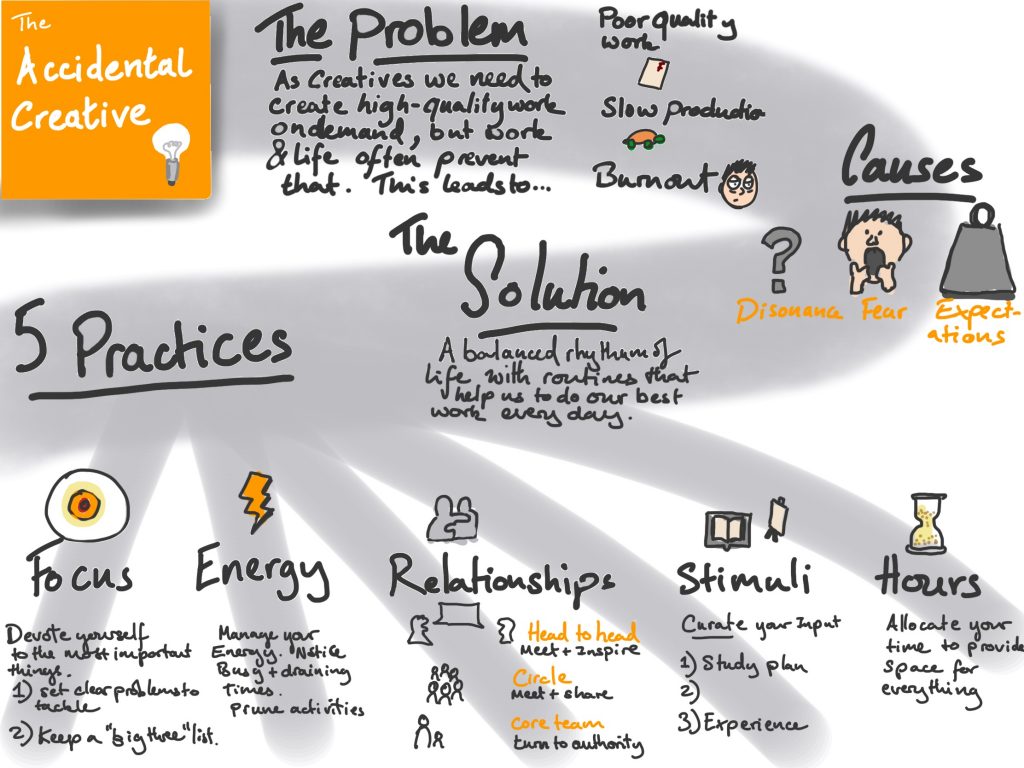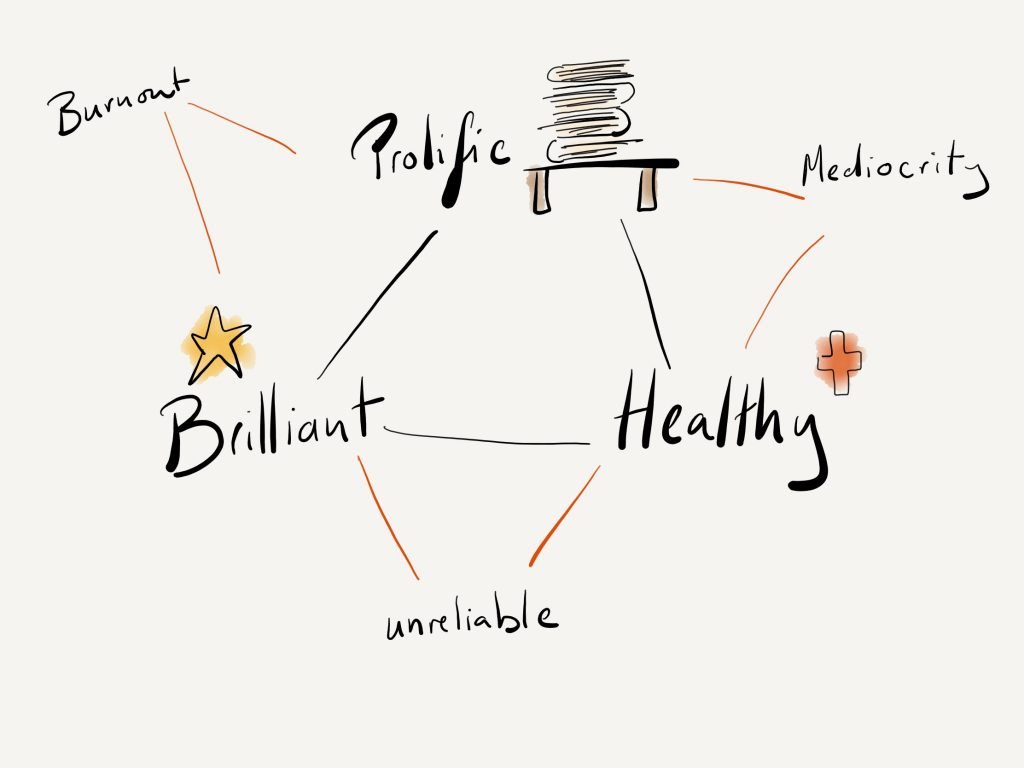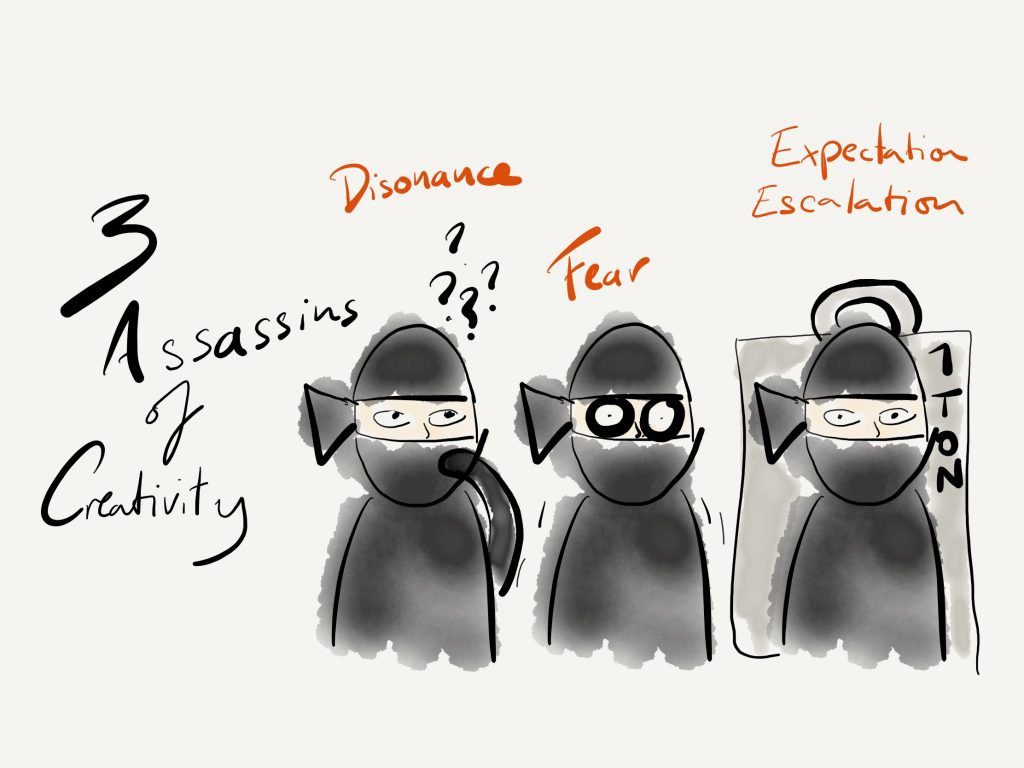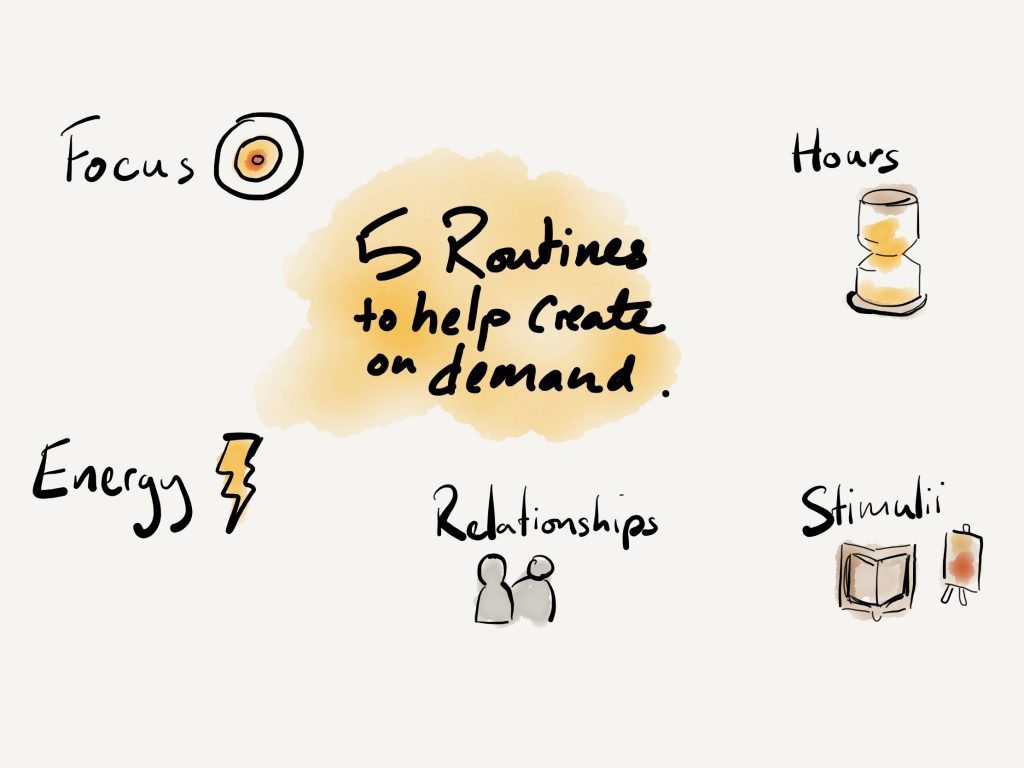The Accidental Creative is a book by Todd Henry who runs a website of the same name. It covers the challenges of creative work, what causes those challenges, and five practices to help avoid those issues. I have written this The Accidental Creative Book summary to help distil my understanding and key lessons from the book. It is not a comprehensive guide to every aspect of the book.
The Accidental Creative book summary Sketchnote

The Problem: being brilliant every day
As professional creatives, we have to be brilliant every day. We are only as good as our last idea and our next one had better exceed our last.
If we were amateurs then we could relax, take the pressure off and just enjoy the process. But that’s not easy when your income is on the line and your manager or client even more spectacular work than yesterday’s product.
To cope, we usually try to brute force our way through creative blocks. We spend more and more time on projects, but that ultimate just leads to burn out.
The Goal: Sustainable Brillance

There are three characteristics of great creative work, but we can usually only get two at a time.
- Prolific – generating large amounts of work
- Brilliant – generating high-quality work
- Healthy – Not feeling emotionally, physically and spiritually drained.
Achieving two at a time is easy but when one aspect is missing, we either are unreliable, mediocre or burnout. The goal, is to manage to achieve all three. To produce high-quality work on a regular basis and not breakdown or split from our families.
The Obstacles: The Assassins of Creativity

There are 3 pressures that prevent us from doing our best creative work.
- Disonance – confusion caused by unclear systems, tasks and objectives. This causes creatives to spend effort working out the task or dealing with the system than doing the task.
- Fear – both of success and failure. We become worried about the repercussions of our actions and so trend towards safety and stability instead of taking needed risks.
- Expectation Escalation – We can reject good ideas because they aren’t great. This pressure can come from inside the project, from our past success and from looking at our competitors. Many great ideas have humble beginnings.
The Soltuion: Creating a routine that aids creativity
We can’t guarantee that our next project will be our best, but we can guarantee that we will fully apply ourselves. If we implement a series of routines and habits, we can ensure that we aren’t overwhelmed with stress. Instead, we will have an abundance of inspiration to draw upon when we create.

These habits fall into five areas
- Focus – directing your efforts where they are best placed.
- Energy – whole life planning to avoid burnout and prepare for challenging times.
- Relationships – cultivating purposeful relationships to help each other grow.
- Stimuli – avoiding distractions and reducing low-quality input while feasting on rich creative input.
- Hours – Managing your time to ensure that important tasks get done.
Adding more can actually help you get more done.
It seems counterintuitive that adding extra activities can help you get more done, but it can be true in creative work. Most creative work tasks require a breakthrough, insight or motivation. When you are burned out, it will take you far longer to complete even easy tasks.
By adding extra process and activities, you can be more well rested and inspired which allows you to more effectively address tasks. This means you can do more, and work more effectively.
But this doesn’t mean you should work extra long hours. It may be better to take a good break and regain your energy than try to push through the creative barrier.
Implementing practices that drive creativity
There is a challenge between reflecting too often, leading to overthinking, and too infrequently, not benefiting from reflection. By adopting weekly, monthly and quarterly checkpoints you can strike a balance. These items can be used alongside other systems.
The difference between weekly, monthly and quarterly checkpoints
Each checkpoint looks at the forthcoming time period mentioned in the name. So a weekly checkpoint looks at the week ahead, while monthly ones look at the following month and Quarterly the subsequent quarter.
Consequently, a weekly checkpoint is much more detailed orientated while the quarterly checkpoint is more focused on the big details.
While the weekly lays out an agenda for the following week according to set in place principles, the quarterly examines the big picture. Quarterly checkpoints reflect on your principles and makes adjustments to apply in your weekly and monthly actions.
Reflective prompts for the 5 Creative Practice
The following section includes reflective prompts to bring these creative practices in your life.
1. Focus
Focus is about identifying the most important activities that will bring about the greatest results and match your values. It’s not just about work, but your personal life as well.
Focus is also about being clear over what you are actually doing. A clear project helps avoid wasting time. This can come from working out what you are doing, or finishing a project and then realizing it’s wrong.
- At quarterly checkpoints, establish areas of focus. Make sure you list personal and professional.
- Set (quarterly) or review (monthly, weekly) your “big three” (These are big challenges you need to address. Make sure you write them as challenges answering “What am I really trying to do?”)
- At weekly checkpoints, Identify any tasks you can cluster together.
2.Relationships
Being intention with your relationships allows you to find stimulating, inspiring and challenging creators to help and be helped by. These can (and should) be people in similar areas or in wildly different fields.
At your weekly checkpoint, check if you need to meet with anyone, what you should prepare and schedule your meet ups. At your quarterly checkpoints, consider your relationships and note times to meet.
- Head to heads – meetings with individual people where you prepare something to share that is interesting you at the moment and may interest them. A relationship to ignite the creative spark in each other. This relationship may last for a season. Meet every month or so.
- Circles – A group meeting where you share work, ideas and challenges to draw collective wisdom and accountability. These groups may come, go and change. Meet every month.
- Core team – Individuals whose opinions and whose perspectives you want on major decisions. These relationships should last a long-time, but they too may change over time due to commitments. The most infrequent meeting you will have.
3.Energy
Energy is about managing your ability to perform. Some times you will be more drained than others. Some tasks and personal commitments can be more draining. Noticing these trends and commitments that will drain you allow you to plan to avoid burnout.
Weekly planning focuses more on moving projects on a day-to-day basis. Quarterly planning should look more at regular activities and week-long projects or commitments.
For example, if you have a major work project one week, it’s probably best to scale back personal commitments that week.
- Identify any large projects and commitments. Pay close attention to possible conflicts.
- Identify activities that should be pruned. Perhaps it seemed like a good idea at the time, but now it isn’t.
4.Stimuli
Many of us consume mostly low-quality input that is pushed to us such as pop TV, the news, and social media. While there is nothing wrong with this content, it shouldn’t be the only content we consume.
It’s much better to get some high-quality content in the form of serious study material and time-tested classics.
In your quarterly checklist you should focus on identify the types of materials and projects you will do. In your weekly checklist you should look at your study, project and experience lists and select the best items for that week.
- Make a study plan with areas where you are lacking knowledge (25%) things you are interested in (50%) and What would be good for you (25%).
- Review your notes on material you have studied recently.
- Plan stimulating experiences (nature, museums, out of comfort zone locations, service opportunities).
Hours
Hours is about allocating your precious time to all the activities you have listed. Although it is tempting to focus just on work, make sure you allocate time for every part of your life. This should include stimulation and unnecessary creating.
In your quarterly planning sessions, look at the major time commitments on the horizon. Also look at your general routine and patters. When would be a good time to spend studying? What activities are at an ill-suited time? When could you move them to?
I remember having a Polish class very early in the morning. I always arrived feeling tired and found it hard. We moved it thirty minutes later, and I was a far more effective student.
Get your copy of The Accidental Creative
If you have found my Accidental creative book Summary interesting, you might want to purchase a copy of the book. It goes into more specifics on how to reflect on each point.
You can find more book summaries here.

Leave a Reply